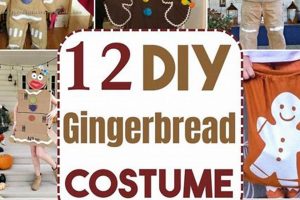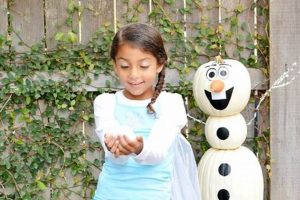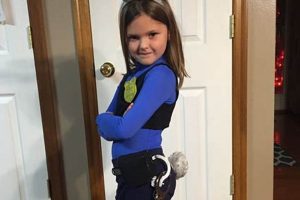Creating a self-made Perry the Platypus outfit involves the construction of attire that resembles the popular animated character. The elements of the costume typically include a teal body, orange feet, a brown beaver tail, and a distinctive platypus bill. The construction of this outfit frequently employs materials such as felt, fabric, and various crafting supplies, with design choices varying based on the creator’s skill level and desired aesthetic.
Handcrafting character-themed attire promotes creativity and resourcefulness. Constructing such a costume offers a personalized and often more cost-effective alternative to purchasing pre-made versions. The practice of creating these outfits extends back to the rise of character-based media, with individuals seeking to embody their favorite figures through homemade apparel for events, conventions, or personal enjoyment. The appeal lies in the unique expression and personal investment involved in the creation process.
The following sections will delve into the different methods and material options available for creating each component of the costume, focusing on practical construction techniques and design considerations to ensure a successful and recognizable final product. These methods will encompass a range of skill levels, from simple, no-sew approaches to more complex tailored designs.
Tips for Crafting a Perry the Platypus Outfit
Effective construction of a Perry the Platypus outfit necessitates careful planning and execution. Attention to detail and material selection significantly impacts the final result.
Tip 1: Prioritize Material Selection. Opt for high-quality felt or fleece in the correct colors (teal, orange, and brown). Durable fabrics enhance longevity and visual appeal.
Tip 2: Accurate Proportions are Essential. Utilize reference images to ensure the bill, feet, and tail are appropriately sized relative to the body. Deviations from the character’s established design can diminish recognizability.
Tip 3: Consider Construction Method. Choose a construction technique suited to skill level. Simple methods, such as hot-gluing felt pieces, are suitable for beginners. More complex projects benefit from sewing techniques.
Tip 4: Secure Fastenings are Crucial. Ensure closures, such as zippers or Velcro, are durable and discreet. Proper fastening prevents the costume from shifting or falling apart during wear.
Tip 5: Focus on the Bill. The bill is a defining characteristic. Employ stiff interfacing or padding to maintain its shape. Accurate color and curvature are paramount.
Tip 6: Address Comfort Considerations. Prioritize comfort by using breathable fabrics and allowing for sufficient movement. The outfit should not restrict mobility or cause overheating.
Tip 7: Tailoring the Tail. Use lightweight materials and batting to create the tail. This avoids making the tail too bulky or heavy, ensuring it is securely attached to the body.
Adherence to these recommendations improves the overall quality and wearability of the final product. Precision and thoughtful execution contribute significantly to a successful character representation.
The concluding section will address potential variations and advanced techniques for further customization and refinement of the outfit.
1. Teal Body Fabric
The “Teal Body Fabric” functions as the foundational element of any credible self-assembled Perry the Platypus attire. Its selection directly impacts the costume’s visual fidelity. Inaccurate hue selection, for instance, replacing the distinctive teal with a generic blue or green, compromises the recognizability of the character. This directly affects audience perception and the costume’s overall effectiveness. Examples from convention attendees highlight the correlation between correct teal fabric choice and positive reception of homemade Perry the Platypus costumes. Fabric quality is also important. A low-grade material may appear faded or easily tear, diminishing the costumes professional aesthetic. Therefore, deliberate selection of a durable, accurately colored teal fabric is crucial.
Beyond aesthetics, fabric properties impact comfort and wearability. A breathable, lightweight teal fabric allows for extended wear without causing overheating or discomfort. This is particularly relevant in settings such as costume parties or conventions where wearers may be active for long durations. Conversely, a heavy or non-breathable fabric can lead to fatigue and reduce enjoyment. The selected “Teal Body Fabric” should balance visual accuracy with practical comfort considerations. Practical application shows that a softer material increases comfort.
In summary, “Teal Body Fabric” is a critical determinant of success. Precise color matching, material durability, and wearer comfort are directly linked to its selection. Failure to prioritize these aspects results in a compromised representation of the character, reducing the impact and wearability of the finished costume. The fabric choice is a foundational consideration that cannot be overlooked in the crafting endeavor. The practical applications are clear in terms of costume recognition, durability and wearability.
2. Orange Foot Appliques
Orange foot appliques are integral to a self-constructed Perry the Platypus outfit. Their presence is a defining characteristic, establishing immediate visual recognition of the character. Absence or inaccurate representation of these appliques significantly detracts from the costume’s authenticity. For example, if appliques are too small, incorrectly shaped, or colored differently, the costume may be mistaken for a generic teal animal rather than Perry the Platypus. The precise shape and placement of these components are crucial for effective character portrayal. Consequently, the orange foot appliques directly influence the overall success of the self-made attire. The accurate size is very important to ensure the accurate visual from the audience. The orange foot appliques provide the image to be successful and the quality of the appliques will be judged from the audience.
The creation of these appliques requires meticulous attention to detail. Common approaches involve cutting the desired shape from orange felt or fabric and attaching it to the foot portion of the costume. Secure adhesion is paramount; poorly attached appliques are prone to detachment during wear, compromising the costume’s appearance. Some builders employ stitching for enhanced durability, while others utilize fabric glue. The choice depends on the creator’s skill level and the materials used. Furthermore, consistent size and shape across both appliques is important for visual harmony. Variations in design across foot appliques can be distracting and detract from the intended aesthetic. Examples of successful costumes often dem
onstrate this symmetry, enhancing the overall impression.
In conclusion, the orange foot appliques are not merely decorative elements; they are essential identifiers in self-made Perry the Platypus attire. Their accurate design, secure attachment, and symmetrical presentation directly impact the costume’s recognizability and overall quality. Challenges in their creation stem primarily from achieving precise shapes and durable adhesion. Overcoming these challenges through careful planning and execution elevates the final product, reinforcing the connection between detailed craftsmanship and effective character portrayal. The importance of the orange appliques contribute to the success of the costume, increasing the audiences visual satisfaction.
3. Brown Tail Construction
The fabrication of a brown tail constitutes a critical aspect in the creation of a self-made Perry the Platypus attire. Its accurate representation significantly impacts the costume’s overall authenticity and recognizability. A poorly constructed tail detracts from the desired character likeness, potentially undermining the entire endeavor. Therefore, careful attention to detail during the tail construction phase is essential.
- Material Selection
The choice of materials for the tail construction directly impacts its appearance and durability. Common options include felt, fleece, and foam. Felt offers a readily available and inexpensive option, suitable for basic constructions. Fleece provides a softer, more plush appearance. Foam, particularly craft foam or upholstery foam, can offer structure and volume. The selection should consider the desired aesthetic and the level of structural support required. Improper choice may result in a limp, misshapen tail that fails to capture the character’s attributes.
- Shape and Size
The tail’s shape and size must accurately reflect the character’s design. It is generally depicted as a flattened, beaver-like tail, wider at the base and tapering towards the end. Proportional accuracy is essential; a tail that is too large or too small will appear disproportionate and detract from the overall costume. Template use, scaled proportionally to the wearer, ensures dimensional correctness. Real-world examples show that incorrectly sized tails often result in a less convincing Perry the Platypus representation.
- Attachment Method
The method of attaching the tail to the body of the costume must ensure both security and comfort. Common techniques include sewing, gluing, or using Velcro. Sewing provides a durable and discreet attachment, particularly when integrated into the seam of the costume. Gluing offers a simpler alternative but may be less robust over time. Velcro allows for detachability, which can be useful for storage or cleaning but may also be prone to accidental detachment during wear. The selected method must withstand the stresses of movement and activity without causing discomfort to the wearer.
- Internal Structure and Support
For larger or more elaborate tail constructions, internal structure and support are necessary to maintain shape and prevent sagging. This can be achieved using wire, cardboard, or stuffing. Wire provides flexibility and allows the tail to be posed. Cardboard offers a rigid structure. Stuffing provides volume and a soft, pliable feel. The selection depends on the desired level of rigidity and the overall weight of the tail. Insufficient support results in a tail that droops or collapses, diminishing the costume’s visual impact.
The successful “Brown Tail Construction” is thus inextricably linked to the overall success of crafting a credible self-made Perry the Platypus attire. Attention to material selection, shape and size accuracy, secure attachment, and adequate internal structure are critical factors that determine the quality and effectiveness of the final product. Neglecting these aspects compromises the intended character portrayal, reducing the visual impact of the completed costume.
4. Beak Shape Accuracy
The precision of the beak shape is paramount in the construction of a self-assembled Perry the Platypus costume. This component serves as an immediate visual identifier, allowing for rapid and unambiguous recognition of the character. Inaccurate representation of the beak directly correlates with a diminished perception of the costume’s fidelity. A beak that deviates significantly from the established dimensions and contours of the animated character introduces ambiguity, potentially causing misidentification or a diluted character representation. The beak, therefore, acts as a linchpin for the costume’s overall success.
Practical application highlights the importance of accurate beak construction. Costumes displayed at conventions or public events demonstrate a clear trend: those with meticulously crafted beaks receive heightened recognition and positive feedback. Methods employed to achieve this accuracy range from detailed pattern drafting to the utilization of sculpting techniques. Fabric selection also plays a crucial role, with stiffer materials such as buckram or heavy felt often preferred to maintain the beak’s intended shape. The internal support structure, such as wiring or foam inserts, contributes to the beak’s rigidity and prevents deformation during wear. These construction decisions directly impact the beak’s visual accuracy and durability, which, in turn, influences public perception.
Achieving optimal beak shape presents several challenges. Maintaining symmetry, replicating the character’s distinctive curvature, and ensuring secure attachment to the headpiece require a high degree of craftsmanship. Overcoming these challenges necessitates careful planning, precise execution, and iterative refinement. A well-constructed beak elevates a self-made Perry the Platypus costume from a generic animal outfit to a recognizable and credible character portrayal. Thus, focusing on achieving “Beak Shape Accuracy” is not merely an aesthetic consideration; it is a fundamental requirement for a successful DIY creation.
5. Hat Attachment Method
The “Hat Attachment Method” represents a crucial element in the successful execution of a do-it-yourself Perry the Platypus costume. A secure and unobtrusive attachment is paramount to maintaining the integrity of the character’s distinctive fedora, ensuring it remains in place throughout wear. Improper or inadequate attachment compromises the costume’s recognizability and functionality.
- Adhesive Application
Adhesive methods, involving fabric glue or similar bonding agents, provide a straightforward approach for securing the hat. However, the longevity and resilience of adhesive bonds are susceptible to environmental factors such as temperature and humidity. Furthermore, excessive adhesive application can result in visible residue or fabric distortion, negatively impacting the costume’s aesthetic. Real-world examples demonstrate that adhesive attachments often require reinforcement or periodic reapplication to prevent hat displacement during active use.
- Sewn Integration
Sewing the hat directly onto a headpiece or wig cap offers a more robust and durable attachment solution. This method involves strategically stitching the hat’s brim or base to the underlying structure, creating a secure bond that withstands movement and handling. Sewn integration necessitates careful planning and execution to ensure the stitches remain concealed and do not compromise the hat’s shape or integrity. Examples from professional costume design showcase the effectiveness of sewn attachments in maintaining hat stability and visual appeal.
- Velcro Fastening
The utilization of Velcro fasteners provides a detachable attachment option, allowing for convenient hat removal and cleaning. This method involves affixing Velcro strips to both the hat’s underside and the corresponding area on the headpiece. While Velcro offers ease of use and adjustability, its holding power is limited by the size and quality of the Velcro strips used. Instances of hat detachment due to insufficient Velcro adhesion underscore the importance of selecting high-grade Velcro and ensuring proper alignment during application.
- Internal Harness System
An internal harness system, constructed from elastic straps or adjustable bands, offers a secure and customizable hat attachment solution. This method involves creating a framework within the hat that conforms to the wearer’s head shape, providing a snug and stable fit. Harness systems are particularly effective for larger or heavier hats, preventing slippage and distributing weight evenly. Examples from theatrical costume design illustrate the use of harness systems to maintain hat positioning and stability during demanding performances.
In summary, the “Hat Attachment Method” directly impacts the overall success of a handmade Perry the Platypus costume. Each attachment approach offers distinct advantages and disadvantages in terms of security, durability, and ease of use. The selection of an appropriate attachment method necessitates careful consideration of the costume’s design, the wearer’s activity level, and the desired level of adjustability and maintainability.
Frequently Asked Questions
This section addresses common inquiries regarding the creation of self-made Perry the Platypus attire, providing clarity on design choices, construction techniques, and material selection.
Question 1: What is the optimal method for maintaining the shape of the platypus beak?
Employing a stiff interfacing material, such as buckram, laminated between layers of fabric offers structural integrity. Alternatively, sculpting the beak from craft foam and adhering fabric to the exterior can achieve a similar effect. Internal wire supports can further reinforce the shape and prevent deformation.
Question 2: What are the most durable fabric choices for a long-lasting costume?
Fleece, felt blends, and durable woven fabrics exhibit superior resistance to wear and tear compared to thinner, less robust materials. Reinforcing seams and stress points further enhances the costume’s longevity.
Question 3: How can accurate color matching for the teal fabric be achieved?
Consulting a color swatch catalog or utilizing online color matching tools enables identification of the closest available teal shade. Purchasing fabric samples and comparing them to reference images of Perry the Platypus ensures greater accuracy.
Question 4: What is the recommended approach for attaching the orange feet to the costume’s shoe coverings?
Sewing the orange feet directly onto durable shoe covers provides a secure and long-lasting attachment. Fabric glue can serve as an alternative, but its bonding strength may require reinforcement. Ensuring proper alignment and consistent placement is crucial for visual harmony.
Question 5: How can the beaver tail be constructed to ensure it does not sag or droop?
Incorporating a lightweight internal frame, such as wire or cardboard, provides structural support. Padding the tail with batting or stuffing maintains its volume and shape. Secure attachment to the costume’s rear prevents excessive movement or sagging.
Question 6: What considerations should be made for costume comfort during extended wear?
Selecting breathable fabrics minimizes overheating. Ensuring ample room for movement prevents restriction and discomfort. Smoothing interior seams and edges eliminates chafing. Incorporating adjustable closures allows for personalized fit and ventilation.
These FAQs address key challenges encountered during the creation process, offering practical solutions to enhance the quality and wearability of the finished costume. Attention to detail and adherence to these recommendations increase the likelihood of a successful outcome.
The following section will provide a series of step-by-step instructions for constructing the costume, incorporating the insights gleaned from the FAQs.
Conclusion
The preceding analysis delineated the essential elements and construction techniques necessary for a successful “diy perry the platypus costume”. It explored fabric selection, component construction, attachment methods, and comfort considerations, emphasizing the importance of accurate representation and durable assembly. The effectiveness of a homemade Perry the Platypus outfit hinges on meticulous attention to detail and a comprehensive understanding of character design.
The creation of a compelling self-made Perry the Platypus costume requires dedication and skill. By adhering to the principles outlined herein, individuals can produce a recognizable and enjoyable representation of this iconic character, thereby contributing to the culture of creative expression and self-sufficiency within the cosplay and crafting communities. Continued exploration and refinement of techniques will undoubtedly lead to even more innovative and impressive iterations of this popular costume.







